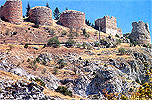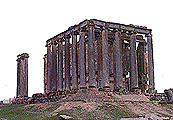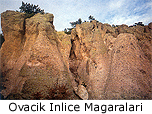
GENERAL
INFORMATION ABOUT KU
SHORT HISTORY
Its establishing is not exactly know but is goes to 3000 B.C. Famous story teller EZOP wsa born in Kutahya. To ancient sources, Kutahyas ancient name was Kotiaeon, Cotiaeum and Koti. The people settled in the city place were Frigs. They lived in Ankara Gordion, Eskisehir Yazılıkaya, Kutahya Sabucupınar and Gediz, Afyon Iscehisar, Uşak and Denizli. Coming to Anatolia in 100 B.C, Frigs occupied the Hittite Empire and establised new state. In 676 B.C, Kimmers beat the King of Frigya, Midas and became the dominant in Kutahya and its neighborhood.
In term of Alyattes in Lidya, he took the managing of this area. In 546 B.C Persians beat the Lidya army and invaded the Anatolia.
In 334 B.C, Alexandra beat the Lidya army near Biga Stream and became the dominant in that environment. With the Dead of Alexandra in 323 B.C, Kutahya and its neigborhood was began to directed by Antiganos. In 133 BC, Kutahya became the center of bishoprik and directed by Roma Empire.
In 1071, Alpaslan and Byzantium Emperor Romanus Diogenes fought in Malazgirt. Alpaslan won the fight and forgave Romanus Diogenes. He came to Kutahya and stayed there some time.
In 1078, the founder of the Anatolian Seljuk Empire, Kutalmısoğlu Suleyman Sah, conquested Kutahya. 1097 Crusaders made on attcact to there. Kılıcaslan II took back Kutahya with the lands which are lost in war. In 1277 Gıyaseddin Keyhusrev gave Kutahya and its neighborhood and the daughter of Germiyanoglu Suleyman Sah, Devlet Hatun to the son of Murat I. Yıldırım Beyazıt.(1381). The land of Germiyanoğulları Principality was given to Otoman Empire as trousseau. In 1402, In Ankara War, Tımur beat Beyazıd and occupied Kutahya and gave it back to Sultan Yakup II. And than, Kutahya became the part of Otoman Empire and state center.
In term of Sultan Beyazıd II., the supporter of Sah Ismail, Sahkulu, rebelled in Kutahya. This rebel was prevented in 1511.
In XIX, the son of Egypt governor, who rebelled againist Otoman Empire, occupied Kutahya. Kutahya Pact was signed by Sultam Mahmut and so the soldiers of Egypt turned back.
In Europe, in time of 1848 revolutions, also Hungars Rebelled. When the rebel was ended by Russia and Austria, some of rebellious leaders were taken refuges by Otoman Empire. They stayed some time in Kutahya until 1851.
The first Compact Business Contract was signed in Kutahya all over the world. It was signed on July 13, 1766 in the presence of governot Ali Pasa, to determine the salary of workers between the workers and the employers.
In 1867, Kutahya was a state center which was dependent to Hudavendigar city. But, after Constitution II, it became an independent state. In National Struggle years, it was occupied by Greeks on July 17, 1921. Kutahya was salvaged from the occupation on August 30, 1922 and become a city on October 8, 1923.
THERMAL
TOURISM(HOT SPRINGS)
Totaly there are 33 hot springs in Kutahya. Ilıca Harlek hotspring, Yoncalı Tutav Thermal Facilities, Yoncalı Healy Mudy Bath, Gediz hotspring, Hamamkoy hotspring, Hisarcık Sefakoy and Esire, Mountain Murat hotsprings, Tavsanlı Gobel hotsprings, Emet hotsprings, Simav Thermal Facilities have an important location in Turkey Thermal Tourism.
HISTORICAL
AND CULTURAL PLACES
Cavdarhisar Aizonoi Ancient City, Frig Valley, Kutahya Castle,
Mosque, ancient settlement centers and the Whirling Casino in Hisar, Ulucami(Great
Mosque), Sultan Yakup II, Balıklı, Kursunlu, Donenler, Arslan Bey, Hisarbeyoglu
Mustafa, Takvacılar, Karagoz, Ahmet Pahsa, Lala Huseyin Pahsa, Ali Pahsa(Alo
Pahsa),Ihsak Fakih and Mollabey Mosques and collection of buildings surrounding
the mosque; Vacidiye Medrese, Demikapılı Medrese(Now Archeology Museum), Gavur
Turkish Bath, Pahsa Turkish Bath, Germiyanoglu Street, Macar House are the
historical places that worth to be seen. And also City Private Tale Museum, Sadık
Atakan Private Tale Mueseum and Dumlupınar Martry Graveyard and Dumlupınar
Monument are the places that you can find lots of wonderful Works belonged our
history.
NATURAL
BEAUTIES
Radar and its neighborhood, Kirazlı
Plateau, Mountain Yellice, Enne National Park and Dam Lake, Sofça Dam Lake,
Frig Valley, Sabuncupınar Plateau, Hisarlık, Çamlıca, Gediz, Mountain Murat,
Saphane, Akdag, Gediz Akçaalan Plateau, Simav Golcuk Plateau,, Emet Egrigoz
Lake and Plateau, Tavsanlı Plateau,, Ilıca Harlek and Yoncalı Picnic Areas
are some of natural beauties that
Kutahya have.
CLIMATE
Kutahya has a transfer featured climate between continental climate of inner Anatolia with Aegan and temperete climate of Marmara. While summers pass hot and dry, cold and rainy winters in eastern parts of our province, in western parts effects of milder maritime climate is sovereign.
AGRICULTURE AND ECONOMY
Kutahya is improving day by day in terms of economical situation. Weaving Carpets and taling is very progressed. Our main industry areas are; Altın Tale, Guven Tale, Edip Tale, Eren Tale, Small and big taling workshops, Akdemir Textile Industry(weaving), Seher Textile, Gurpınar Cogwheel Factory, Brick Factory, Kutahya Porcelain, Kutahya Ceramics, Kutahya Vit, Kutahya Cartoon, Art & Craft Glass, Kutahya Kumas Brick Factory, Kutahya Eti-Gumus Foundations, Kutahya Azot Industry, Gediz Gimsan, Gediz Package Industry, Gediz Water Pipe Industry, Kocadaglar Furniture Industry, Simav Timber and Furniture factories, Seyitomer and Tuncbilek Coal managements, Emet Colemanit Managements.
ARTISTS AND SCIENTISTS
Kutahya is also famous with its artists and scientists. Evliya Celebi, Tale Craftsman Hacı Hafız Emin Efendi, Ali Pahsa, Ord. Prof. Dr. İsmail Hakkı Uzuncarsili are same of our famous and dear artists from past. In our time, Painter Huseyin Yuce, Ahmet Yakupoglu, Huseyin from Alayunt and Ahmet Duygu are our favotite painting artists. In addition to them, tale craftsman Sıtkı Usta, Mehmet Gursoy, Ahmet Mumtaz Yıldız, Zeki Oncu, Osman Erez and Birol Akdemir are our dear photographers. With these artists and craftsman, our city has an important position in culture and art tourism.
LOCATION
OF KUTAHYA
Kutahya is far from Eskisehir 74 Km, Afyon 90 Km, Usak
and Bilecik 120 Km, Bursa 200 Km, İstanbul-Ankara-İzmir-Antalya 450 Km.
and also, it takes place on the center of big cities.
|
Independence
Days
|
Name
of the Festival |
Starting Date |
Celebrition
Date |
|
Independence of Kütahya |
Kutahya |
1923 |
30 August |
|
Independence of Emet |
Emet |
1922 |
3 September |
|
Independence
of Simav |
Simav |
- |
4 September |
|
Independence
of Gediz |
Gediz |
1926 |
1 September |
|
Independence of Tavsanli |
Tavsanli |
1928 |
3 September |
|
Victory
Festival |
Kutahya-Dumlupinar |
1923 |
30 August |
|
Fairs |
|
|
|
|
Dumlupinar
Fair |
Kutahya-Center |
1974 |
7-27 July |
|
Festivals |
|
|
|
|
Tile Festivals |
Kutahya-Center |
1986 |
7-9 July |
|
Puclic
Celebrations |
|
|
|
|
Rye
Tourism Celebrations |
Cavdarhisar |
1984 |
17 July |
|
Competition
of encouragement of production of Strawberyy
|
Domanic
(Safa Village) |
1977 |
First half of June |
|
Remembering
of Hayme Ana and Domanic
|
Domanic
(Ebecamligi) |
1985 |
First week of June |
|
Oily Wrestlering match |
Domanic |
1972 |
Last Sunday of may |
GENERAL
INFORMATION
Area
: 11.875
Population
: 600.000
Towns
: Kutahya (Ciyt Center), Aslanapa, Altıntas, Domanic, Cavdarhisar, Dumlupınar,
Emet, Gediz, Hisarcık, Simav, Pazarlar, Şaphane, and Tavsanlı.
According to census of the year 1990 population is 578.000 and the population of the center is 131.000. The density of population is 49 %. The city covered the 1.53 % of Turkey Area
SOME INFORMATION ABOUT THE HISTORY OF KUTAHYA
MOSQUES AND MUSEUM
1
Ulu Camii (Great Mosque)
It is in the city center in Borekciler street between Vacidiye Medrese and Sultan Yakup II Complex of Building. The biggest and the best mosque of Kutahya was built by Yıldırım Beyazıt and complated during the period of Fatih Sultan Mehmed and restorated bey Mimar Sinan during the period of Kanuni Sultan Süleyman. Averagely it takes place 45x25 m area and it has not got a court. It has a minamet on the north east corner and have 3 doors and 64 windows. There is a holy pulpit sat on four marble columbs and a fauntain in the middle of the mosque. The top and the side parts of that dome are seperated by apartition for women. It has also got two domes, six semi domes and five regions for the lastcongregations.
2
Ali Pasha (Alo) Mosqeu
It is stated in Gazi Kemal ward, in Cumhuriyet Street. It was built in 1796 with its wooden roof. Itn has two enterings in north and west. It likes a square and has a wooden supplement in its west part. The roof is supported by 8 columbs. Mihrab and its wall is covered with lots of different tales. And so, it is said that these tales are taken from different places.
3
Yeşil Camii (Green Mosque)
It is in Hukumet Streer and was built in the periodof Abdulhamit II.(1905). It is a square building with one done and the entrance havet two columbs and a dome, too. The inside of the mosque was adorned with relief and paintings. And also it is an unique sample with its decorative gallery of minaret in Kutahya.
4
Karagoz Ahmet Pasha Mosque
It was built between 1509 1512 years and was full of covered with stones. It has a big some and regions for the last congregations and its minaret was built from bricks. These Bricks are used with stones to decorate the mosque.
5 Çinili Camii(Yakupoğlu Camii) Tilen
Mosque
It was built in 1073 and its inside and outside is covered with full of tiles. It reflects Turkish Architectural period of Middle Asia and has one octagon dome which is decorated with Turkish motifs. It was constructed by Ahmet Yakupoglu that is an unique sample in Kutahya and also in the world.
It is in the Vacidiye Complex of buildings and it is the second private museun in the world.
In this building, yhe historical Works, some of which are found in Kutahya and its neighborhood, some of which are bought by money are shown. In addition to historical Works,You can find ethnographical goods in this museum.
8 Kossuth House
It is a Turkish house fron 18 th centruy Lajos KOSSUTH, who was one of the leaders of Hungarian Liberation War, camr to Kutahya and stayed 2 years withh his refugees in this house afterthey went this house become a museum.
9 Sadık Atakan Private Tale Museum
Sadık Atakani who loves Kutahya, tale and culture, is from
Kutahya. Before starting to work as a lawyer, he had a big curiosity to tales.
So he gathered lots of tales and established the first tale museum in Kutahya,
in the house where he was born.
HISTORICAL BULDINGS
1 Kutahya Castle
The
castle of Kutahya which has been settled since ancient times, is existed from 3
differenet part. They are upper, imer and lower fort. Castle was settled in the
period of Romans, Byzantie, Seljukians and Otoman Empire. It has any epitaphs
which is belonging to any times. According to Evliya Celebi, this castle hsa 70
castle towers. Today , KutahyaCastle looks like Diyarbakır Castle. Its castle
towers are very close to each other and also in the inside of the castle, there
are some castles that get stuck to the other castle towers.

2 Other Buildings in the Castle
While going to Hisar Cafe from Castle
Mosque, there are 2 fountains which are not used anymore.
3 Aizanoi
Ancient city, 57 km to the town center is in Cavdarhisar town. It
is settled on two banks of Bedir stream and improved in Christian time(AC 98
117). The five Roman Bridgen which connects the river bank of the ancient river,
stil survive anda re in use. On the left side of the river thete are Aroga, a
small temple, Zeus Temple, Turkish Bath, stadium and a theatre. On the right
side, thete are the remainder of Exchange buildins, mosaic bath, street of
columbs and monumental door. Graveyard spread out to the environment. In
the excavation, in 1978, the caldarium(temperature), frigidarium(coldness),
palaestra(sports court), F and H saloons, hatation(pool) parts were found and so
the bath plan was complated. Theatre and stadium are very close toeach other and
the temple is higher than the other buildings. On the cella wall, it was written
that the building was be longed to the Hadrians period. Zeus temple was used
as a church in Christian term. And stil for German Archeology Institution, Dr.
Klaus Rheidt has been doing the excavations. This studies are being done near
the Exchange Building in street of column.

4 Frig Valley
It is 55 km. to Kutahya. This valley takes place from the east
part of Ovacık village. It was used by Romans, Byzantie and Frigs in 900
600- B.C. There are hundreds of caves, tombs, castles and shaples and also on
the you can see painted crosses, different ornamenti writtings, carvings, and
decorations. While the region was being examined, its was seperated into 3 parts.
In the first part, two churchs was found carved to a big rock. In the second
part, hole stone castle was used by Frigs and Byzantie. Fot defance and shelter
the rocks were corved and thete are lots of small rooms and a
hidden passage between the church and the rooms.
This region looks like Urgup in terms of its nautual rocks. And in
Ahmetoglu Çiftliği, Sabucupınar, Fındık, Incik, İnli and Sogut villagesi
there are lots of caves and churchs.

TALE IN KUTAHYA
1 Art of Kutahya Tale
Tale is the symbol of our city and it introduces Kutahya yo whole
world. And also, it is not only an art, it is also a subsistance resources for
people.
Making ceramics begun in Frigs term and progressed until the end
of the Byzantie term. More than 100 years, it is a tampon area between Byzantie
and Sejukians. In this period, both cultures were used in tale Works. And than
the Otoman influence began to be sean in art Works. In 1314, the coffin of Abdülvacir
Efendi in Vacidiye Complex of Building and in 1428, colorful tale bricks are
seen in Sultan Yakup Complex of Buildings Especially, White-blue tales takes the
attention and these tales are seen in Hsarbey an Kukurt
villageMosques. And these tales were also used in İstanbul and Kudus. In
16 Th century, tale and art activities worsened but tales of Kutahya were going
on used in buildings which wrere built in big and important cites. White-blue
tales of Kutahya were used Gebze Çoban Mustafa Pasha Tomb, Mainsa Valide Sultan
Mosque and in some units of Topkapı Palace.
And nowadays, art of tale is improving and the tales done in small workshops are decorating lost of buildings all over the world.
2 Taling Methods in Kutahya
The raw materials which are used in making tale is gotten from
Kutahya and the other neighbor cities. These row materials are seperated to 2.the
firs one is plasticmaterials that are Kırklar soil, grey Bilecik clay, fermentg
and linen stones, while Bilecik clay and chalk.
By Mixing these materials in determined proportions, 3 different
mixtures are obtained which named Wheel, casting and pres. On whell thresher
flat wall plates, vases, flower pots and sugarbowls; on casting theresher knicks-knacks,
cups, plates are made. The materials coming from mines are firstly grinded and
mixed with flitestones in the mill.
Plastic
substances are blended and wited 1-2 days in pools and than they are sifted and
rested 20-25 days. Non plastic substances are also boiled, sifted and added to
trashing. The rested thresher and the rate of water in the plastic substance are
equalized . Casting threster is generally prerared in well thresher. In some
workshops, in specific rates flintstone is added to wheel thresher and also pres
thresher is prepared in dry form.
The for is given to thresher with Wheel, casting or pres most of
the wheels used by foot. Most of the pres moulds are wooden and the qualitiy of
the plaster cast is not good and the technology is not improved. Drying is done
in indooorsi n winter and done in outdoors in summer.
The kiln which is in a cylindrick shape are done by lining upthe brick in different size and have different sizes and have different parts. In the cooking part there are lots of shelfs. In the fire part, there are two Windows that the tales are watched from there. Cooking degree is reach to 800 900 degree in 11 -14 hours. Double cooking method is used to cook the tales. The paints are got from local and foreign sources . Gren, torquaz, red and black are the local paints generally donbe from oxide. Yellow, dark, gren and dark blue are foreign paints. By using thes colours, lots of different colours can be obtained.
CULTURE
In our city, in additionto tale art and silver
management,
carpeting is an important handicraft which is improving day by day. Espicially
in Simav, carpeting improves as a house weaving. In Cavdarhisar and Emet,
Yagcibedir Carpets, In Pazarlar Kilims which are weaved from bristle and
woolen, and in Şaphane, Aslanapa-Bayramşah villages weaving is very spreaded
an famous.